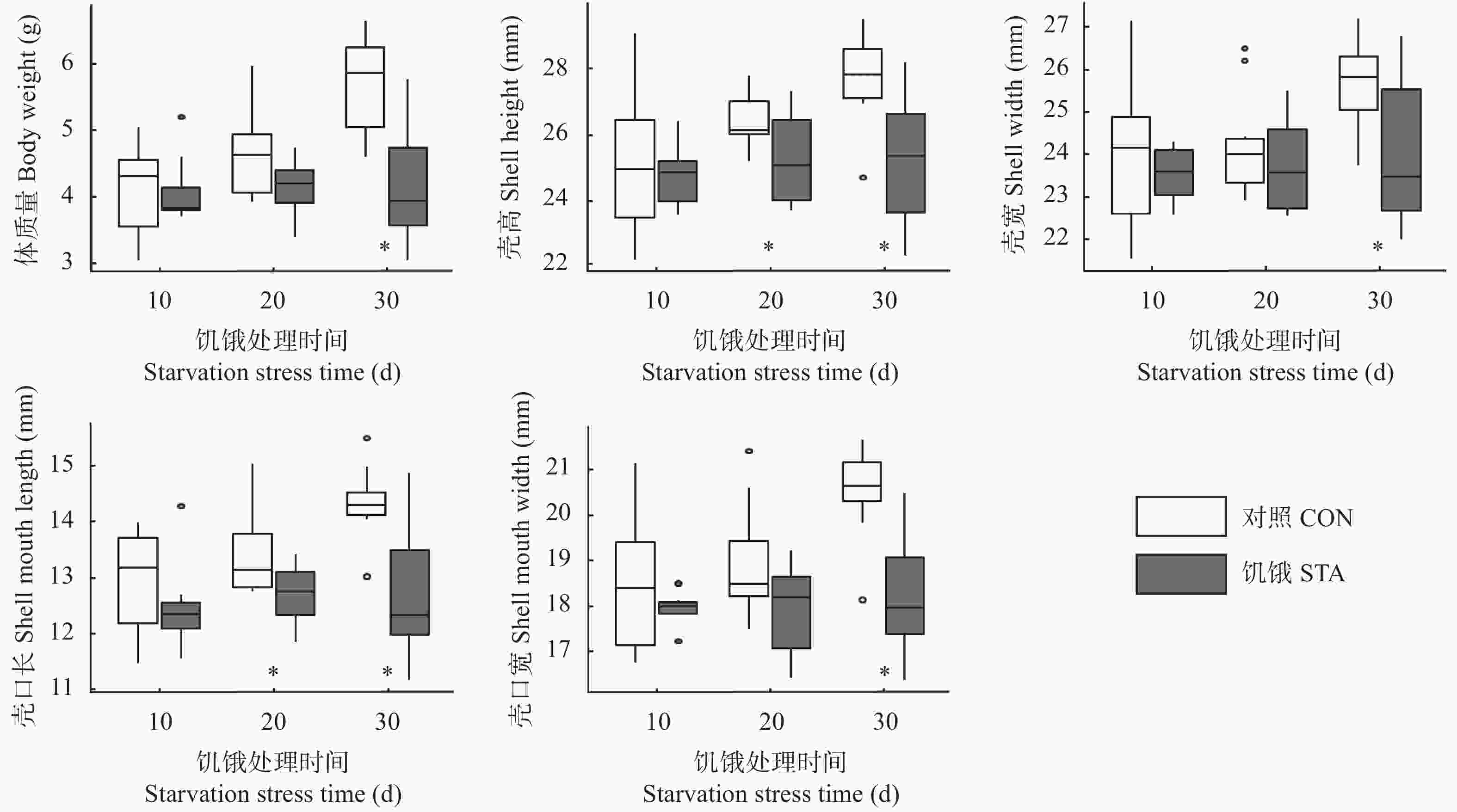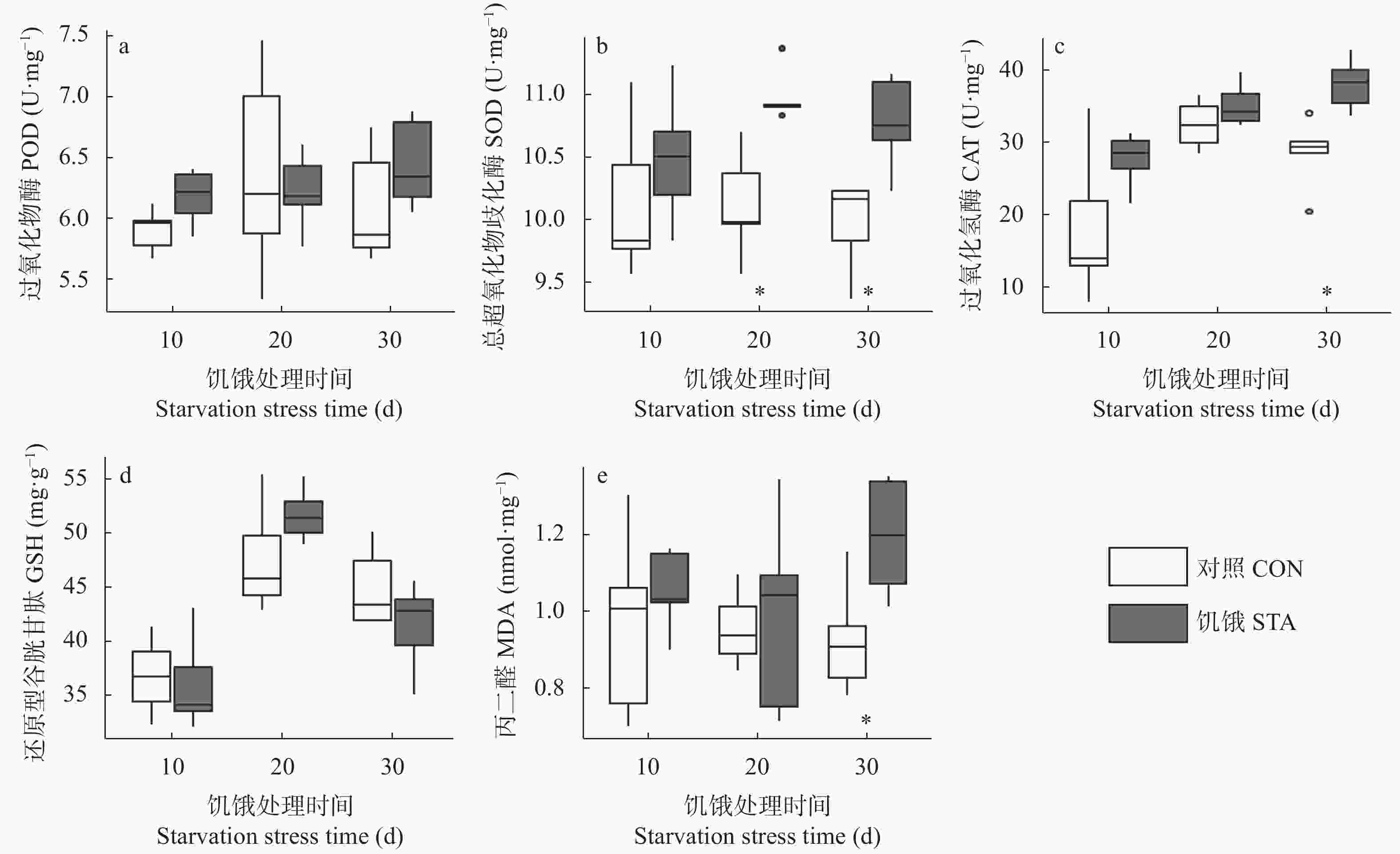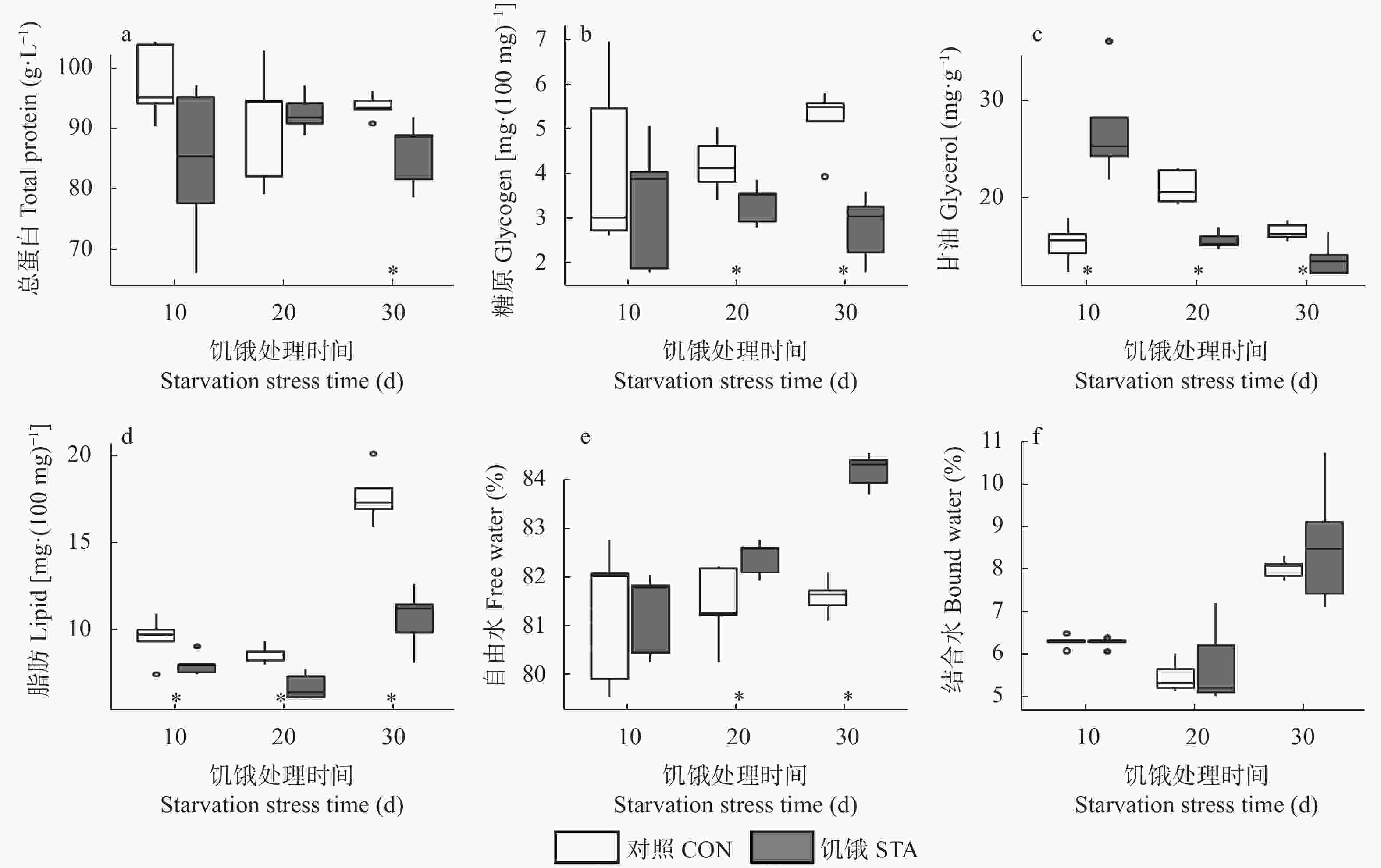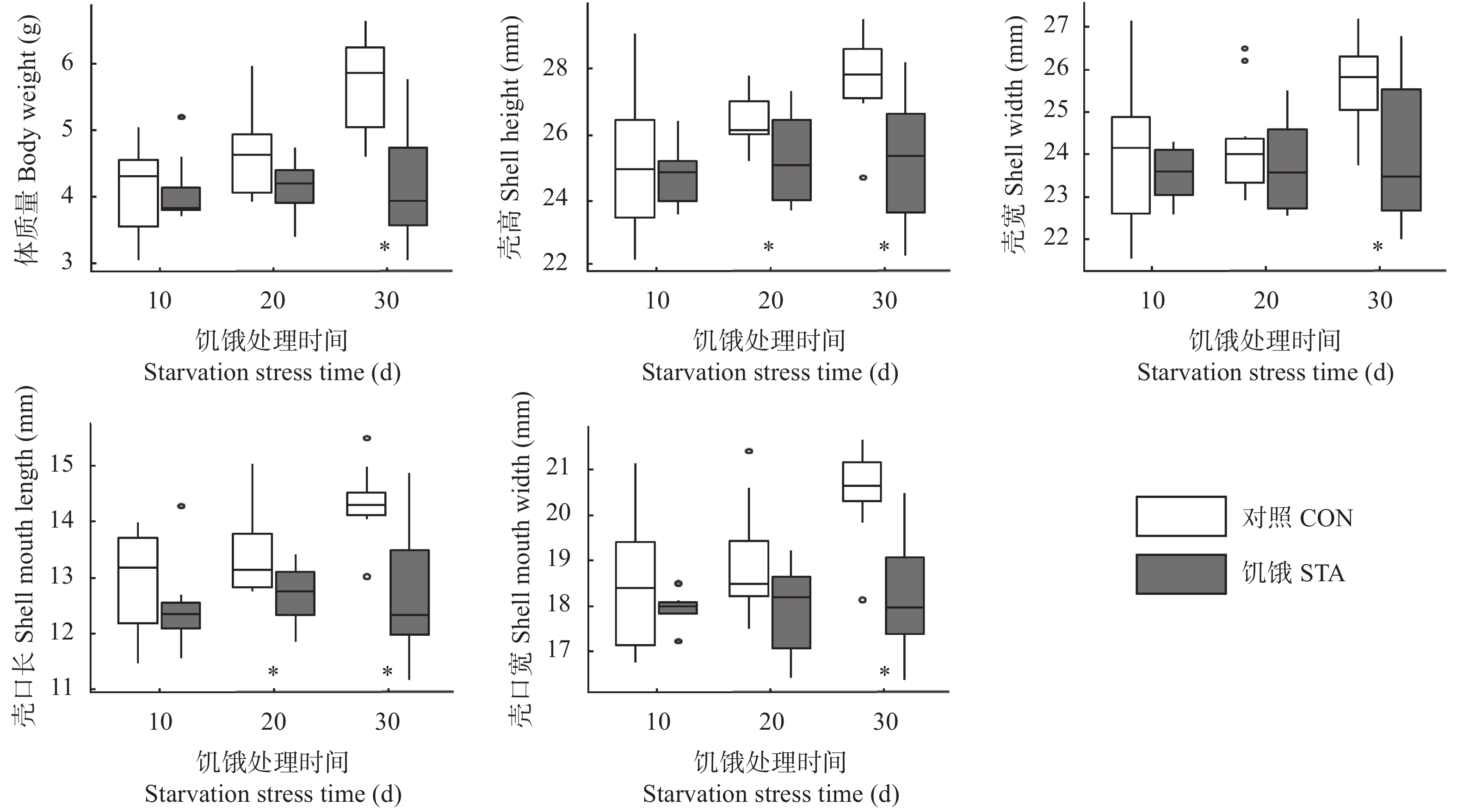Effects of starvation stress on growth, antioxidant system and biochemical substances of Pomacea canaliculata (Lamark 1822)
-
摘要: 福寿螺是一种具有重大危险性的外来入侵生物, 威胁水稻和水生作物生产, 带来了巨大的经济和生态损失。饥饿胁迫是生物经常面临的环境压力之一, 为探讨福寿螺对饥饿胁迫的生理生态学响应, 以稻田福寿螺为研究对象, 研究了10 d、20 d和30 d的饥饿胁迫对福寿螺生长、抗氧化系统及生化物质含量的影响。结果表明, 随着饥饿时间的延长, 福寿螺自由水含量持续上升, 从20 d开始显著高于对照(P<0.05), 30 d时处理组福寿螺自由水含量平均值为84.19%, 显著高于对照组的81.60% (P<0.05)。饥饿胁迫使福寿螺生长发育受到抑制, 壳高和壳口长从20 d开始显著低于对照(P<0.05)并持续至试验结束。体质量、壳宽和壳口宽在前20 d并未与对照组产生显著差异, 随着饥饿时间延长至30 d, 各生长指标均显著低于对照(P<0.05)。面对饥饿胁迫, 福寿螺消化腺抗氧化能力提高, 总超氧化物歧化酶活性从20 d开始显著高于对照并持续至试验结束(P<0.05); 过氧化氢酶活性及丙二醛含量在前20 d未与对照形成显著差异, 但随饥饿时间延长至30 d而显著高于对照(P<0.05); 饥饿胁迫对福寿螺过氧化物酶活性和还原型谷胱甘肽含量无显著影响; 甘油含量呈“先增后降”的趋势, 在10 d时显著高于对照(P<0.05), 随后迅速降低, 在20 d和30 d时显著低于对照组(P<0.05); 脂肪含量在3个观测时段内均低于对照(P<0.05), 糖原含量在20 d时开始低于对照并持续至试验结束(P<0.05); 总蛋白含量只有在30 d时显著低于对照(P<0.05), 其他观测时段并未与对照形成显著差异。总之, 福寿螺可通过减缓生长、提高抗氧化能力、消耗内源性生化物质等一系列生理机制来缓解短期饥饿胁迫带来的影响, 限制食物来源可在一定程度上抑制福寿螺的暴发与危害。Abstract: Pomacea canaliculata is a highly dangerous invasive alien species that threatens rice and aquatic crop production, thereby causing large economic and ecological losses. Starvation stress is an environmental pressure that organisms often face. Under starvation conditions, organisms slow down growth and development and consume energy storage substances to provide energy to maintain life activities. To investigate the physiological and ecological responses of P. canaliculata to short-term starvation stress, the effects of 10, 20, and 30 d of starvation stress on the growth, antioxidant system, and biochemical substances of P. canaliculata were studied. The results showed that the free water content of the snails continued to increase with the increased starvation time and was significantly higher than that of the control from 20 d onwards (P<0.05). The mean content of free water of the snails in the treatment group was 84.19% at 30 d, which was significantly higher than that of the control group at 81.60% (P<0.05). The growth and development of snails were inhibited by starvation stress, and shell height and shell mouth length were significantly smaller than those of the control after 20 d (P<0.05) and the inhibition persisted until the end of the experiment. Body weight, shell width, and shell mouth width were not significantly different from those of the control during the first 20 d. As the starvation period was extended to 30 d, all the growth indicators were significantly lower than those of the control (P<0.05). Under the starvation stress, the antioxidant capacity of the snails was improved, and the total superoxide dismutase activity was significantly higher than that of the control from 20 d until the end of the experiment (P<0.05). There was no significant difference in the catalase activity and malondialdehyde content between the first 20 d and the control; however, they were significantly higher than those of the control with the extension of the starvation time to 30 d (P<0.05). There was no significant difference in the peroxidase activity or reduced glutathione content between the starvation stress and control groups. The glycerol content showed a trend of increasing then decreasing; it was significantly higher than that of the control at 10 d (P<0.05), then decreased rapidly, and was significantly lower than that of the control at 20 d and 30 d (P<0.05). The lipid content was lower than that of the control at all three observation periods (P<0.05), the glycogen content was lower than that of the control at 20 d and remained low until the end of the experiment (P<0.05). The total protein content was significantly lower than that of the control at 30 d (P<0.05) but did not differ significantly from that of the control at the other observation periods. The results suggest that P. canaliculata can mitigate the effects of short-term starvation stress via a number of physiological mechanisms such as slowing growth, increasing antioxidant capacity, and depleting endogenous biochemicals. Limiting the food source can inhibit the outbreak and damage caused by P. canaliculata to a certain extent.
-
图 1 饥饿胁迫对福寿螺生长的影响
CON和STA分别代表正常摄食和饥饿处理。图中*表示饥饿对福寿螺生长造成显著影响(P<0.05)。
Figure 1. Effects of starvation stress on the growth of Pomacea canaliculata
CON and STA represent the treatments of normal feeding and starvation stress, respectively. * indicates significant impact of starvation stress on the growth of the snails (P<0.05).
图 2 饥饿胁迫对福寿螺抗氧化系统的影响
CON和STA分别代表正常摄食和饥饿处理。*表示CON和STA间差异显著(P<0.05)。
Figure 2. Efects of starvation stress on antioxidant system of Pomacea canaliculata
POD: peroxidase; SOD: superoxide dismutase; CAT: catalase; GSH: glutathione; MDA: malondialdehyde. CON and STA represent the treatments of normal feeding and starvation stress, respectively. * indicates significant impact of starvation stress on the antioxidant system of the snails (P<0.05).
图 3 饥饿胁迫对福寿螺生化物质含量的影响
CON和STA分别代表正常摄食和饥饿处理。*表示CON和STA间差异显著(P<0.05)。
Figure 3. Effects of starvation stress on the contents of biochemical substances in Pomacea canaliculata
CON and STA represent the treatments of normal feeding and starvation stress, respectively. * indicates significant impact of starvation stress on the biochemical substances of the snails (P<0.05).
-
[1] 章家恩, 方丽. 关于我国农田福寿螺生物入侵需要加以研究的生态学问题[J]. 中国生态农业学报, 2008, 16(6): 1585−1589ZHANG J E, FANG L. Ecological issues of research for biological invasion of Ampullaria gigas Spix in China[J]. Chinese Journal of Eco-Agriculture, 2008, 16(6): 1585−1589 [2] 冯伟明. 福寿螺的生物学特性及防治措施[J]. 广东农业科学, 1994, 21(6): 41−42FENG W M. Biological characteristics and control measures of Pomacea canaliculata[J]. Guangdong Agricultural Sciences, 1994, 21(6): 41−42 [3] HALWART M. The golden apple snail Pomacea canaliculata in Asian rice farming systems: Present impact and future threat[J]. International Journal of Pest Management, 1994, 40(2): 199−206 doi: 10.1080/09670879409371882 [4] 刘军, 何跃进, 谭济才, 等. 自然条件下福寿螺繁殖特性[J]. 应用生态学报, 2012, 23(2): 559−565LIU J, HE Y J, TAN J C, et al. Characteristics of Pomacea canaliculata reproduction under natural conditions[J]. Chinese Journal of Applied Ecology, 2012, 23(2): 559−565 [5] 郭靖, 章家恩, 刘文, 等. 间歇性干旱对福寿螺生长、抗氧化能力和消化酶活性的影响[J]. 中国生态农业学报, 2014, 22(12): 1484−1490GUO J, ZHANG J E, LIU W, et al. Effect of intermittent drought on growth, antioxidant capacity and digestive enzyme activity of Pomacea canaliculata[J]. Chinese Journal of Eco-Agriculture, 2014, 22(12): 1484−1490 [6] KILLEN S S, MARRAS S, MCKENZIE D J. Fast growers sprint slower: effects of food deprivation and re-feeding on sprint swimming performance in individual juvenile European sea bass[J]. Journal of Experimental Biology, 2013: DOI: 10.1242/jeb.097899 [7] SILVA-CASTIGLIONI D, VALGAS A A N, MACHADO I D, et al. Effect of different starvation and refeeding periods on macromolecules in the haemolymph, digestive parameters, and reproductive state in Aegla platensis (Crustacea, Decapoda, Aeglidae)[J]. Marine and Freshwater Behaviour and Physiology, 2016, 49(1): 27−45 doi: 10.1080/10236244.2015.1099205 [8] POWELL M L, WATTS S A. Response to long-term nutrient deprivation and recovery in the crayfishes Procambarus clarkii and Procambarus zonangulus (Crustacea, Decapoda): Component and proximate analyses[J]. Journal of the World Aquaculture Society, 2010, 41(1): 71−80 doi: 10.1111/j.1749-7345.2009.00314.x [9] 王林龙, 王展, 张雪梅, 等. 不同底质和温度对金乌贼仔乌饥饿耐受能力的影响[J]. 中国水产科学, 2018, 25(5): 1071−1081 doi: 10.3724/SP.J.1118.2018.17375WANG L L, WANG Z, ZHANG X M, et al. Effects of different substrate and temperature on hunger tolerance in Sepia esculenta juveniles[J]. Journal of Fishery Sciences of China, 2018, 25(5): 1071−1081 doi: 10.3724/SP.J.1118.2018.17375 [10] 徐大凤. 真蛸幼体生长发育及环境胁迫对幼体的影响[D]. 上海: 上海海洋大学, 2019XU D F. Studies on larvae development of Octopus vulgaris and the effects of environmental stress on larvae[D]. Shanghai: Shanghai Ocean University, 2019 [11] 李林明, 王灿华, 何亮华. 饥饿对菲律宾蛤仔消化酶活力与抗氧化能力的影响[J]. 福建农业科技, 2016(1): 21−23LI L M, WANG C H, HE L H. Effect of starvation on digestive enzyme activity and antioxidant capacity of Ruditapes philippinarum[J]. Fujian Agricultural Science and Technology, 2016(1): 21−23 [12] 王帅, 任道全, 宋勇, 等. 饥饿胁迫对叶尔羌高原鳅抗氧化能力的影响[J]. 西南农业学报, 2016, 29(9): 2249−2252WANG S, REN D Q, SONG Y, et al. Effects of starvation stress on antioxidant capacity of Triplophysa (Hedinichthys) yarkandensis (day)[J]. Southwest China Journal of Agricultural Sciences, 2016, 29(9): 2249−2252 [13] 章承军, 刘健, 陈锦辉, 等. 饥饿再投喂对缢蛏消化酶活力和抗氧化能力的影响[J]. 水产学报, 2010, 34(7): 1106−1112ZHANG C J, LIU J, CHEN J H, et al. Effects of starvation and refeeding on digestive enzyme activity and antioxidative capacity of razor clam (Sinonovacula constricta)[J]. Journal of Fisheries of China, 2010, 34(7): 1106−1112 [14] MORALES A E, PÉREZ-JIMÉNEZ A, HIDALGO M C, et al. Oxidative stress and antioxidant defenses after prolonged starvation in Dentex dentex liver[J]. Comparative Biochemistry and Physiology Part C: Toxicology & Pharmacology, 2004, 139(1/2/3): 153−161 [15] DOMENICALI M, CARACENI P, VENDEMIALE G, et al. Food deprivation exacerbates mitochondrial oxidative stress in rat liver exposed to ischemia-reperfusion injury[J]. The Journal of Nutrition, 2001, 131(1): 105−110 doi: 10.1093/jn/131.1.105 [16] 韩微. 福寿螺对逆境胁迫的行为反应及生理生化反应研究[D]. 南宁: 广西大学, 2012HAN W. Study on the behavioural and biochemical reactions of forces at different stages of Pomacea canaliculata[D]. Nanning: Guangxi University, 2012 [17] 董胜张, 俞晓平. 食物种类与饥饿胁迫对福寿螺生长发育的影响[J]. 生物安全学报, 2011, 20(3): 213−219DONG S Z, YU X P. Effect of plants species and starvation on the growth of golden apple snail, Pomacea canaliculata (Lamarck)[J]. Journal of Biosafety, 2011, 20(3): 213−219 [18] CAZZANIGA N J. Predation of Pomacea canaliculata (Ampullariidae) on adult Biomphalaria peregrina (Planorbidae)[J]. Annals of Tropical Medicine & Parasitology, 1990, 84(1): 97−100 [19] ESTOY G F Jr, YUSA Y, WADA T, et al. Effects of food availability and age on the reproductive effort of the apple snail, Pomacea canaliculata (Lamarck) (Gastropoda: Ampullariidae)[J]. Applied Entomology and Zoology, 2002, 37(4): 543−550 doi: 10.1303/aez.2002.543 [20] 郭靖, 陈敏, 王玥, 等. 雌雄福寿螺摄食生长及形态性状差异研究[J]. 广东农业科学, 2014, 41(8): 96−100 doi: 10.3969/j.issn.1004-874X.2014.08.023GUO J, CHEN M, WANG Y, et al. Sex-related differences in feeding, growth and morphological characteristics of Pomacea canaliculata[J]. Guangdong Agricultural Sciences, 2014, 41(8): 96−100 doi: 10.3969/j.issn.1004-874X.2014.08.023 [21] 韩瑞东, 孙绪艮, 许永玉, 等. 赤松毛虫越冬幼虫生化物质变化与抗寒性的关系[J]. 生态学报, 2005, 25(6): 1352−1356 doi: 10.3321/j.issn:1000-0933.2005.06.019HAN R D, SUN X G, XU Y Y, et al. The biochemical mechanism of cold-hardiness in overwintering larva of Dend-rolimus spectabilis Butler (Lepidoptera: Lasiocampidae)[J]. Acta Ecologica Sinica, 2005, 25(6): 1352−1356 doi: 10.3321/j.issn:1000-0933.2005.06.019 [22] 徐淑, 周兴苗, 曾俊, 等. 二化螟不同年龄段越冬幼虫的耐寒性比较[J]. 植物保护学报, 2009, 36(1): 11−15 doi: 10.3321/j.issn:0577-7518.2009.01.003XU S, ZHOU X M, ZENG J, et al. Cold hardiness of overwintering larvae of Chilo suppressalis at different ages[J]. Journal of Plant Protection, 2009, 36(1): 11−15 doi: 10.3321/j.issn:0577-7518.2009.01.003 [23] MATSUKURA K, TSUMUKI H, IZUMI Y, et al. Changes in chemical components in the freshwater apple snail, Pomacea canaliculata (Gastropoda: Ampullariidae), in relation to the development of its cold hardiness[J]. Cryobiology, 2008, 56(2): 131−137 doi: 10.1016/j.cryobiol.2007.12.001 [24] 郭靖, 徐武兵, 章家恩, 等. 雌雄福寿螺耐寒能力的差异[J]. 应用生态学报, 2014, 25(6): 1791−1798GUO J, XU W B, ZHANG J E, et al. Gender differences of Pomacea canaliculata in cold tolerance[J]. Chinese Journal of Applied Ecology, 2014, 25(6): 1791−1798 [25] WICKHAM H. ggplot2: Elegant Graphics for Data Analysis[M]. New York: Springer, 2016: 1–253 [26] STEFFENS W. Principles of Fish Nutrition[M]. Ellis Horwood Chichester, 1989: 35–36 [27] 田青, 荣小军, 李彬, 等. 饥饿胁迫对刺参(Apostichopus japonicus)免疫和生长的影响[J]. 渔业科学进展, 2014, 35(4): 71−76 doi: 10.11758/yykxjz.20140411TIAN Q, RONG X J, LI B, et al. Starvation stress effect on the immunity and growth of sea cucumber Apostichopus japonicus[J]. Progress in Fishery Sciences, 2014, 35(4): 71−76 doi: 10.11758/yykxjz.20140411 [28] LI H, XU W, JIN J, et al. Effects of starvation on glucose and lipid metabolism in gibel carp (Carassius auratus gibelio var. CAS Ⅲ)[J]. Aquaculture, 2018, 496: 166−175 doi: 10.1016/j.aquaculture.2018.07.015 [29] 薛明, 柯才焕, 狄桂兰. 饥饿对方斑东风螺形态和组织生化成分的影响[J]. 台湾海峡, 2010, 29(2): 205−211XUE M, KE C H, DI G L. Effects of fasting on the morphology and biochemical composition of tissues of juvenile spotted babylon, Babyloniaareolata[J]. Journal of Oceanography In Taiwan Strait, 2010, 29(2): 205−211 [30] DALL W. Indices of nutritional state in the western rock lobster, Panulirus longipes (Milne Edwards).Ⅰ. Blood and tissue constituents and water content[J]. Journal of Experimental Marine Biology and Ecology, 1974, 16(2): 167−180 doi: 10.1016/0022-0981(74)90018-5 [31] COMOGLIO L, GOLDSMIT J, AMIN O. Starvation effects on physiological parameters and biochemical composition of the hepatopancreas of the southern king crab Lithodes santolla (Molina, 1782)[J]. Revista De Biología Marina y Oceanografía, 2008, 43(2), DOI: 10.4067/s0718-19572008000200012 [32] MCCUE M D. Starvation physiology: reviewing the different strategies animals use to survive a common challenge[J]. Comparative Biochemistry and Physiology Part A: Molecular & Integrative Physiology, 2010, 156(1): 1−18 [33] NAVARRO I, GUTIÉRREZ J. Fasting and starvation[M]// HOCHACHKA P W, MOMMSEN T P. Biochemistry and Molecular Biology of Fishes. Amsterdam: Elsevier, 1995: 393–434 [34] 罗文, 杨受保, 丁盈, 等. 三角帆蚌(Hyriopsis cumingii)珍珠形成初期钙代谢的特征分析[J]. 海洋与湖沼, 2010, 41(6): 895−900 doi: 10.11693/hyhz201006015015LUO W, YANG S B, DING Y, et al. Calcium metabolism in Hyriopsis cumingii during early pearl-forming stages[J]. Oceanologia et Limnologia Sinica, 2010, 41(6): 895−900 doi: 10.11693/hyhz201006015015 [35] 何毛贤, 袁涛, 黄良民. 马氏珠母贝饥饿补偿生长的初步研究[J]. 热带海洋学报, 2010, 29(6): 143−146 doi: 10.3969/j.issn.1009-5470.2010.06.022HE M X, YUAN T, HUANG L M. Preliminary study on compensatory growth in pearl oyster Pinctadamartensi Dunker following starvation[J]. Journal of Tropical Oceanography, 2010, 29(6): 143−146 doi: 10.3969/j.issn.1009-5470.2010.06.022 [36] 赵旺, 温为庚, 谭春明, 等. 饥饿胁迫对猛虾蛄不同组织免疫酶活性的影响[J]. 中山大学学报: 自然科学版, 2021, 60(4): 26−33ZHAO W, WEN W G, TAN C M, et al. Effects of starvation stress on the activities of immune enzymes in different tissues of Harpiosquilla harpax[J]. Acta Scientiarum Naturalium Universitatis Sunyatseni, 2021, 60(4): 26−33 [37] YANG S, LIU Q, WANG Y, et al. Effects of dietary supplementation of golden apple snail (Pomacea canaliculata) egg on survival, pigmentation and antioxidant activity of blood parrot[J]. SpringerPlus, 2016, 5(1): 1556 doi: 10.1186/s40064-016-3051-2 [38] 李晨晨, 朱婷婷, 陆游, 等. 周期性饥饿再投喂对虎斑乌贼幼体生长性能、抗氧化指标、消化酶活性、氨基酸组成和脂肪酸组成的影响[J]. 动物营养学报, 2018, 30(10): 3993−4004LI C C, ZHU T T, LU Y, et al. Effects of periodical starvation-refeeding on growth performance, antioxidant indices, digestive enzyme activities, amino acid composition and fatty acid composition of juvenile Sepia pharaoni[J]. Chinese Journal of Animal Nutrition, 2018, 30(10): 3993−4004 [39] 卢俊姣, 刘淑兰, 翟少伟. 饥饿胁迫对罗非鱼肝胰脏抗氧化能力的影响[J]. 中国农学通报, 2013, 29(35): 75−79 doi: 10.11924/j.issn.1000-6850.2013-1239LU J J, LIU S L, ZHAI S W. Effects of starvation stress on antioxidant capacity in hepatopancreas of tilapia (Oreochromis niloticus)[J]. Chinese Agricultural Science Bulletin, 2013, 29(35): 75−79 doi: 10.11924/j.issn.1000-6850.2013-1239 [40] JANERO D R. Malondialdehyde and thiobarbituric acid-reactivity as diagnostic indices of lipid peroxidation and peroxidative tissue injury[J]. Free Radical Biology and Medicine, 1990, 9(6): 515−540 doi: 10.1016/0891-5849(90)90131-2 [41] MARTÍNEZ M L, PIOL M N, NUDELMAN N S, et al. Tributyltin bioaccumulation and toxic effects in freshwater gastropods Pomacea canaliculata after a chronic exposure: field and laboratory studies[J]. Ecotoxicology (London, England), 2017, 26(5): 691−701 doi: 10.1007/s10646-017-1801-8 [42] 王双健, 丁玉惠, 江茂旺, 等. 饥饿时间对管角螺生长、生化组成、消化酶活性和抗氧化指标的影响[J]. 动物营养学报, 2018, 30(1): 138−146 doi: 10.3969/j.issn.1006-267x.2018.01.018WANG S J, DING Y H, JIANG M W, et al. Effects of starvation time on growth, biochemical composition, enzyme activities and antioxidant indexes of Hemifusus tuba Gmelin[J]. Chinese Journal of Animal Nutrition, 2018, 30(1): 138−146 doi: 10.3969/j.issn.1006-267x.2018.01.018 [43] MOON T W. Adaptation, constraint, and the function of the gluconeogenic pathway[J]. Canadian Journal of Zoology, 1988, 66(5): 1059−1068 doi: 10.1139/z88-156 [44] BARCLAY M C, DALL W, SMITH D M. Changes in lipid and protein during starvation and the moulting cycle in the tiger prawn, Penaeus esculentus Haswell[J]. Journal of Experimental Marine Biology and Ecology, 1983, 68(3): 229−244 doi: 10.1016/0022-0981(83)90055-2 [45] BAYNE B. Aspects of the metabolism of Mytilus edulis during starvation[J]. Netherlands Journal of Sea Research, 1973, 7: 399−410 doi: 10.1016/0077-7579(73)90061-6 [46] 薛明, 柯才焕, 魏永杰. 饥饿对方斑东风螺幼螺生化组成和消化酶活力的影响[J]. 热带海洋学报, 2010, 29(3): 120−125 doi: 10.3969/j.issn.1009-5470.2010.03.020XUE M, KE C H, WEI Y J. Effects of starvation on biochemical compositions and digestive enzyme activities of spotted Babylon, Babylonia areolata juveniles[J]. Journal of Tropical Oceanography, 2010, 29(3): 120−125 doi: 10.3969/j.issn.1009-5470.2010.03.020 [47] RUSSELL-HUNTER W D, EVERSOLE A G. Evidence for tissue degrowth in starved freshwater pulmonate snails (Helisoma trivolvis) from tissue, carbon, and nitrogen analyses[J]. Comparative Biochemistry and Physiology Part A: Physiology, 1976, 54(4): 447−453 doi: 10.1016/0300-9629(76)90048-7 [48] 薛明, 柯才焕, 王德祥, 等. 饥饿与再投喂对方斑东风螺生长、基本营养成分及RNA/DNA比值的影响[J]. 水产学报, 2010, 34(3): 481−488 doi: 10.3724/SP.J.1231.2010.06558XUE M, KE C H, WANG D X, et al. Effects of starvation and recovery on growth, proximate composition and RNA/DNA ratio in juvenile spotted ivory shell (Babylonia areolata)[J]. Journal of Fisheries of China, 2010, 34(3): 481−488 doi: 10.3724/SP.J.1231.2010.06558 [49] VAUGHAN M. The production and release of glycerol by adipose tissue incubated in vitro[J]. The Journal of Biological Chemistry, 1962, 237: 3354−3358 doi: 10.1016/S0021-9258(19)70821-7 [50] 查锡良. 生物化学[M]. 7版. 北京: 人民卫生出版社, 2008ZHA X L. Biochemistry[M]. Seventh Edition. Beijing: People’s Medical Publishing House, 2008 -






 下载:
下载:





